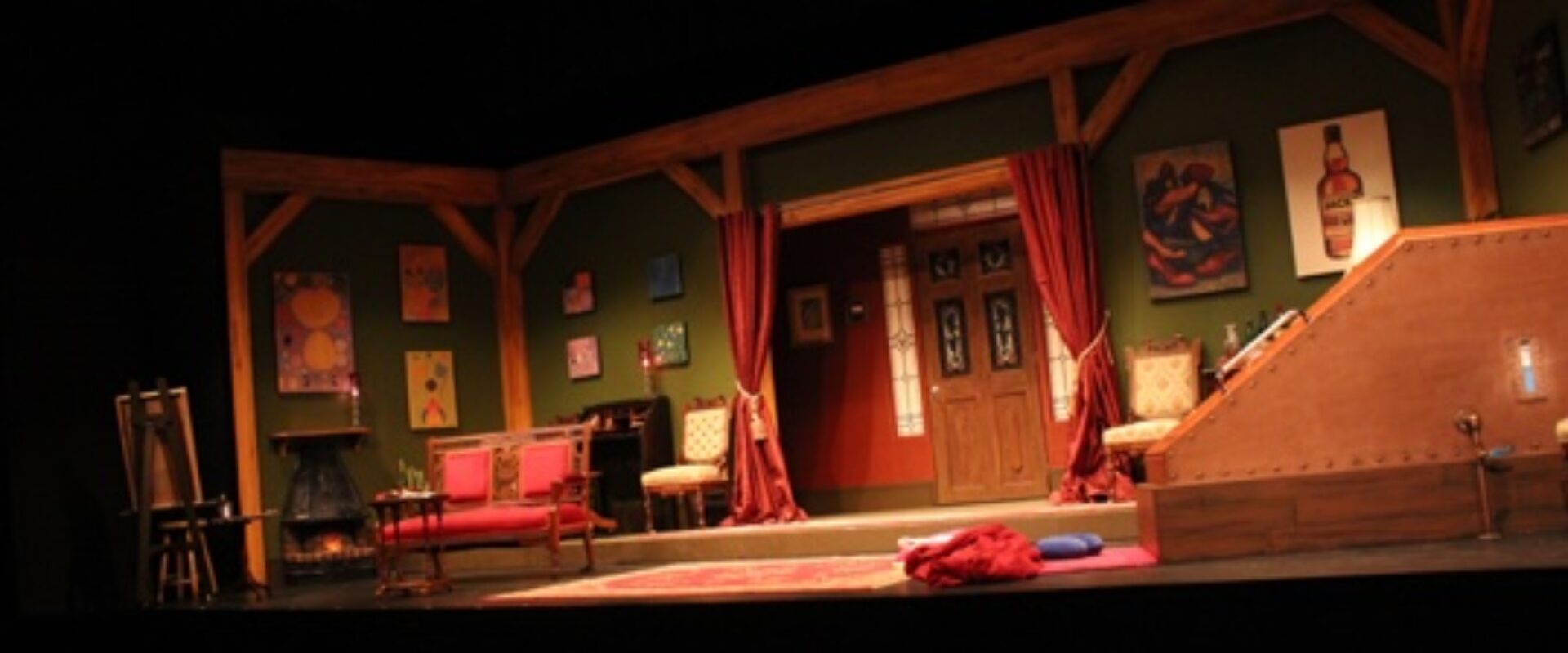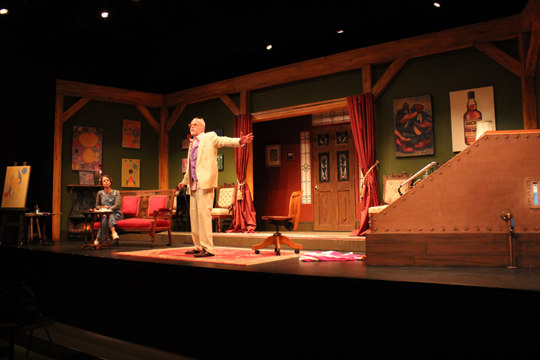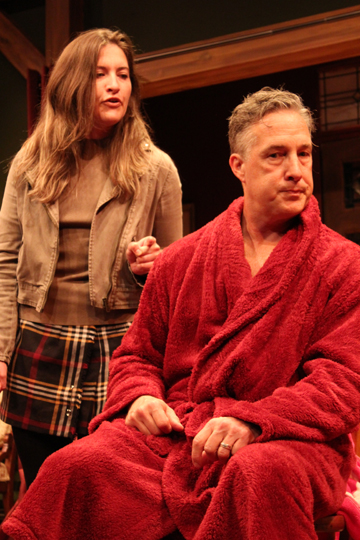REVIEW: Art of Murder is a fun romp

Full of twists and turns, first production of the 150th season at The Players’ Guild of Hamilton is a roller-coaster of a ride.
The Art of Murder is a fun, twisty romp that ends in a satisfying place.
We go into the theatre knowing someone dies, but which of the four characters will it be and why?
You won’t go home from The Players’ Guild of Hamilton’s first production of its 150th season with an especially elevated understanding of what makes these characters tick, or the complicated emotions that drive them to do what they do.
But you will have had an enjoyable couple of hours, laughed out loud, and maybe even gasped a time or two. Who doesn’t enjoy some manipulation, betrayal, deception, and revenge in a murder mystery?
The first thing to be solved: What is that strange hatch-thing in Annie and Jack’s Connecticut living room? Is it a space capsule? A bomb shelter? A coffin? A stairway to the underworld?
The answer comes immediately when Jack Brooks (Brad Forbes) climbs out in a swim suit from his isolation chamber. Forbes shows us right away that Jack is unlikeable and obnoxious.
He talks about himself in the third person and likes to say: “I am an artist. Do not judge me.”
Sorry, Jack, we’re judging you.
He and wife Annie (Andrea Adcock) are clearly not in a good place. They are arguing and there is a palpable undercurrent — is there such a thing as an overcurrent? — of disdain between the two.
We learn that the handsome Jack is a successful artist with an ego to match. His art seller, Vincent Cummings, (Mike Mitton) has been invited to dinner and Jack is going to confront him about why Vincent is not getting Jack’s work sold. The artist is riled up and brandishing a gun.
Housekeeper Kate (Renata Ona), an Irish chemistry student trying to get her green card, walks in on Jack’s rant and produces an ear-piercing scream that is both unsettling and impressive.

It seems Vincent is the intended murder target here.
But perhaps not, because as the play opens, Annie is openly imagining killing Jack. It’s not long before he’s demeaning her and her artistic work. It’s also not long before Jack is trying to have his way with Kate when his wife is out of the room. The feeling is obviously not mutual.
When Vincent arrives — blows in might be a more apt description — we soon learn a young female artist under his wing has taken her own life after reaching a level of celebrity thanks to Vincent’s machinations. Turns out the larger-the-life Vincent isn’t so much torn up by the loss as pleased by how much her death has increased the value of her work.
What starts out as a hypothetical challenge about how Vincent could manage Jack’s fame after his death — “I would make you mythic,” Vincent promises Jack — turns into a real-life plot between Annie and Vincent to kill Jack.
Annie wants out from under her husband’s oppression and we learn he’s been taking credit for her work for years. She has thought long and hard about how to make his death looks like suicide inside the isolation chamber. Vincent is motivated by the chance to make some money and to rid himself of a client with unrealistic expectations of the level of his talent.
But he’s not willing to help Annie get her artistic due. She is, after all, just a female artist. It’s easier to him to continue to sell Jack’s work post-mortem. Shouldn’t she just accept that?
The second act is full of twists and turns, some I saw coming and others I didn’t. Mitton is funny and physical as the flamboyant Vincent but could benefit from turning down the camp volume here and there, so that his humour has room to breathe.
Forbes effectively handles the subtle menace and raging ego of Jack but occasionally feels a bit wooden in his delivery and movements.
Adcock plays the sympathetic and then not-so-sympathetic Annie to great effect and often holds things together as the glue of the production. In a more limited role, Ona makes the most of her time on stage.
There are times when the blocking feels awkward, mostly thanks to the isolation chamber taking up a lot of the stage. As well, a fight sequence is mishandled, over before the audience realizes what’s happening, and an extended kiss between Annie and the openly and unmistakenly gay Vincent is inexplicable and unnecessary.

But no one can quibble with the pace of this show. It’s a roller-coaster of a ride. And the repeated playing of a slowed down, minor key version of Doris Day’s “Que Sera, Que Sera” — Jack’s soundtrack while in his chamber — is quite unnerving.
In a nice touch, Annie’s art hanging on the set walls is inspired by another female artist, Hilma af Klint, who was a prolific and talented painter shelved during her lifetime by the renown of Wassily Kandinsky, who was credited with being a pioneer of the abstract movement even though af Klint’s work clearly predates his.
The Art of Murder, which debuted in 2000, won an Edgar Award winner for Best Mystery Play from the Mystery Writers of America. Playwright Joe DiPietro has had much greater commercial and critical success with the long-running Off-Broadway musical comedy I Love You, You're Perfect, Now Change, the comedy Over the River and Through the Woods and the Tony-winning musical Memphis.
Director Tamara Kamermans effectively sums up The Art of Murder in her director’s notes:
“The Art of Murder by Joe DiPietro is a complex bubbly cocktail: a murder mystery with a zest of fraud, a twist of marital discord and a strong aftertaste of victory over the patriarchy. You’ll think you know who did it at times and why, but the giant tank is full of surprises.”
The play’s conclusion might make you want to cheer, writes Kamermans, “but tomorrow you’ll have the sense that a deeper battle was won.”
NEED TO KNOW
The Art of Murder
Oct. 23, 24, 30, 31, and Nov. 1 at 8 p.m.
Oct. 25, 26, and Nov. 1 at 2 p.m.
The Players' Guild of Hamilton
80 Queen St. S., Hamilton
Tickets are here or by calling the box office at 905-529-0284











